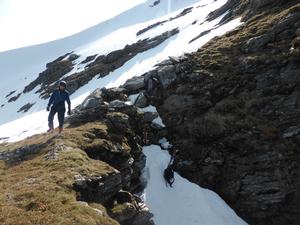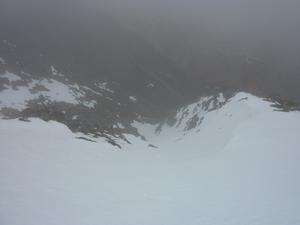
Tactics
It is not the aim of this site to provide any form of instruction, but it is worth sharing some details of how to get some of these lines done.
How to find lines?
The statement in the "Ski Mountaineering in Scotland" guide by the SMC suggests that "Any grade I gully with reasonable width and good snow cover is a possible descent.". This is indeed true, and the best source of finding lines to ski are OS Maps and doing some leg work. For lines that follow graded gullies and faces, then climbing quidebooks will be extremely handy. The most comprehensive source for Scotland is the Scottish Mountaineering Club Climbers' guide series. Buying all the guides wil be a considerable investment, particularly when you are just interested in the easiest lines. Selective guides may exclude some lines that don't appeal to the target market for the selective climbing guide, but this may omit lines that appeal from a skier/boarders point of view.
Of course, ideally this site will become a good source of information ...
How to get to the lines once found?
There's no getting away from it - you need to be prepared to carry your skis/board and boots on your back at some point. Particularly late in the season, when the hillsides are bare and the corries/gullies are holding snow, wearing trainers or lightweight boots is the way to go. You will travel much faster carrying your ski boots than you will wearing them.
With the likes of the Cairngorms, the use of a bike will ease the long approaches. Although it may not seem like it at the time when you are gasping your way uphill with a heavy rucksack, it will be worth it for the way back!. The more weight on the frame rather than on your back the better from an effort point of view. However, you may want to factor in the repacking hassle and time in both directions. There are numerous configurations of carrying skis on a bike. Some strap the skis to the frame of the bike. This works well if your frame allows it, and your bindings are not too bulky. Alternatively, it's on the rucksack, but be aware of catching the tips of the skis on trees as you cycle! A full suspension mountain bike makes a big difference, as the rear shock helps to compensate for the extra weight of the ski kit on your back, reducing the likelyhood of punctures.
When to go?
With reference to all of the lines described, the presence of snow is obviously required. With the unpredictable nature of the Scottish winter, there's no hard and fast rule as to when gully descents can be done. Essentially - you need enough snow, whatever the time of year, but spring is often best.
Secondary to this is the snow stability. Once you have got it, you want it to stay where it is when you are descending it! Generally, once the snow has undergone some freeze-thaw cycles, the stability increases. There is no point in repeating the considerable information relating to avalanche safety, but as a starter, the Scottish Avalanche Information Service site is an excellent resource. It should be noted that this service often ends prior to the best steep skiing conditions.
For the steeper lines, you definitely want good snow stability, but for the snow to be of a consistency that allows for it to be skied in control. Spring skiing in Scotland can be fantastic, when the best steep skiing conditions are upon us. It is also a good time of year to try some of the normally more popular gullies, as many winter mountaineering courses will be finished for the season. You do have to be aware of debris in gullies following a thaw - there is often a surprising amount of rocks in the gullies following a thaw.
In terms of finding out what is complete, or not, it's a case of combining experience, preceding conditions, online reports and luck! There are many sources of information online, some of which can be found in the links page. Climbing report blogs can often provide snippets of relevant information, or even better, pictures. The touring reports section of Winterhighland sometimes includes details of steeper descents.
What to take?
This section is more to deal with the specific additional equipment you may want to consider for the steeper lines, over and above your normal ski-mountaineering equipment. Your entry to the gully may be barred by a cornice, and you may wisely not wish to get too close to the edge without checking it out first whilst anchored in some way. For this reason, if I think there is a chance of this situation occuring, I carry a lightweight harness, a sling and a short length of rope. Using buried skis as an anchor for the rope, a degree of safety can be employed for checking out the entry to a line. This gear will also be useful should you encounter an ice pitch or rock step, and you need to abseil. In order to do this, you will need to have with you some additional gear - how much is up to you.
A climbing axe is overkill for the majority of the descents described on this site. My personal preference is to use one (or two!) of the many good ski mountaineering axes on the market. You want it to be light, with a head that is strong enough to cut steps if required, and a smooth shaft (to keep down weight and help with "plunging"). There's considerable debate over the ideal length of ice axe, with many stating that 50cm is too short to ice axe brake. It's worth pointing out that this discussion usually comes from the point of view of hillwalking/general winter mountaineering, where it is valid. When you are on steep ground, you want an axe that is not cumbersome to use, to help prevent a situation where you are forced to use it as a break. Make your own choice, but 50cm works for me.
New pages and updates to the site, including Gleann Eanaich, Bla Bheinn and Beinn Alligin
07-Apr-21

